If you're a mutant, I have a warning for you. Stay out of the Javits Center. There was a Last Chance Qualifier there earlier today and the results made it clear that you aren't welcome. Should you choose to ignore this warning, confident as you are in your super speed or much vaunted healing factor, you might find yourself on the receiving end of a dose of robot eugenics policy. The first LCQ is over and done with and the final standings reflect one immutable and searing truth—that the best way to win a Last Chance Qualifier and make your way to the big show is with guts, tight play, and a big purple fist. When the dust cleared in the first single elimination event of the day, the only players left standing were those carrying Curve Sentinels in their weathered deck boxes.
In the comic books, these tin-plated characters are an oppressive force that stops at nothing to eradicate those different from the norm. In Vs. System, they're basically playing the same role, but without the same level of genocidal malevolence found on a comic page. Replacing that decidedly hostile feeling is the swagger that comes with being the number one deck in the metagame. It's a game face that says, “Take your best shot, pal.”
Well, everyone did. And at least for now, our heroes have failed. The Sentinels are in control.
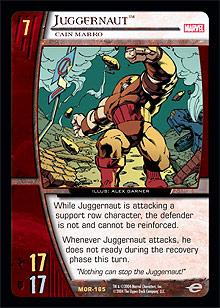 Anthony Cheng, Curve Sentinels
Anthony Cheng, Curve Sentinels
Anthony Cheng's deck is very similar to the decks that were seen at the top tables at $10K Detroit, and as you can see, he has enjoyed similar success. Of note in this design is Cheng's decision not to go overboard with metagame adjustments for such troublesome cards as
Betrayal (with the exception of his one copy of
Juggernaut), opting instead for a more straightforward build. It has been said that those who reach too far in an effort to beat the game may just end up beating themselves. Why worry about
Betrayal if, because of all the
Mojoverse action, no one will bother playing it?
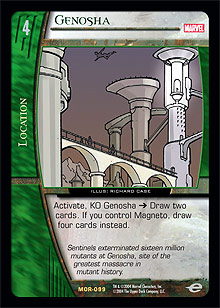 Daniella Girijalra, Curve Sentinels
Daniella Girijalra, Curve Sentinels
Characters
Daniella's build has three major points of interest. First, there are only three copies of
Genosha. At first glance, most people “in the know” tend to point this out as an error, considering the raw power that can be harnessed when a Curve deck hits Magneto and fires off multiple
Genoshas. Second, it uses no copies of
Cover Fire. This is a design element that started to get hot in Australia and Paris and continued through $10K Detroit and into the present day. Third, there are two copies of
Finishing Move. There's no denying that Hounds lock is a lot of fun, so why not try to manufacture that character advantage from time to time . . . without the Hounds?
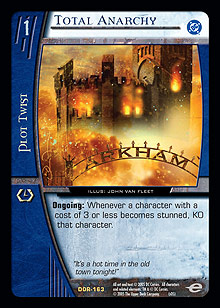 Paul Madden, Curve Sentinels
Paul Madden, Curve Sentinels
Locations
Paul Madden's deck also has some interesting and unique design elements. Paul is one of only a few Curve players who are foregoing the now-standard suite of
Micro-Sentinels in favor of
Total Anarchy.
Total Anarchy vs.
Micro-Sentinels is a close race. When you need to quickly get rid of a 2- or 3-drop,
Total Anarchy is a faster choice (and it isn't targeted, which means that you won't run into trouble with
Personal Force Field on Invisible Woman when playing against those pesky Fantastic Fun decks), and unlike
Micro-Sentinels, it isn't contingent on the number of characters you have in play. That said,
Total Anarchy is far inferior to
Micro-Sentinels when it comes to dealing with
A Child Named Valeria, and that is the issue that has turned more and more Curve players toward the latter card. One final point is that you get no benefit from drawing multiple copies of
Total Anarchy, whereas multiple copies of
Micro-Sentinels can pick a board clean in the early to middle game.
In addition to the
Total Anarchy, you've probably noticed the
Mojoverse. If you follow our coverage this weekend, you're going to see a lot of that card.
Betrayal is worthless now, and all of the so-called Tier 2 decks that had looked to that card as a savior are going to have to go back to their respective drawing boards. Of course, with no reason to fear
Betrayal, Paul has no reason not to run four
Genosha and four Magneto and go about the business of tearing people apart on turn 7.
With only one Hounds and no
Juggernaut, this build is better suited than most new-age Curve builds to get full use out of
Cover Fire, but Madden still saw fit to run only two, along with two
Acrobatic Dodges. With Hounds lock in the mirror a scary possibility,
Cover Fire is becoming more and more of a situational card. Why only one Hounds? In the mirror, Paul may choose to mulligan aggressively in order to find
Boliver Trask, meaning only one Hounds will be necessary.
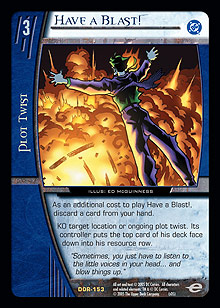 Alvaro Elliott Jiran, Curve Sentinels
Alvaro Elliott Jiran, Curve Sentinels
Characters
Locations
Now here's an interesting specimen, though it may be the weakest of the four qualifying decks. Alvaro's deck features only 29 characters (at least two fewer than most builds) and only three copies of
Genosha. In place of those omitted cards, this Curve build features two copies of
Have a Blast! and three copies of
Mojoverse. Is Alvaro very worried about
Betrayal? Ironically enough, the presence of so many
Mojoverses will probably stomp
Betrayal out of the metagame before “the big one” even starts.
We'll leave that one to philosophers, though I suspect the exorbitant price of the card might have something to do with it.
That's four more Sentinel decks into the mix for tomorrow. And I, for one, welcome our new robot overlords. Far more than the cruel whip that drives the metagame relentlessly forward, Curve Sentinels has a lot of room for variation in both build and play style. When the gauntlet is thrown down on Friday morning, many players will be battling for the prize with what they and others see (and rightfully so) as a proven commodity. The winner will be the player who has tweaked, practiced, and planned. The winner will be the player who can make his or her creation “hum” and get good utility out of cards that fall outside of the Curve Sentinels core.
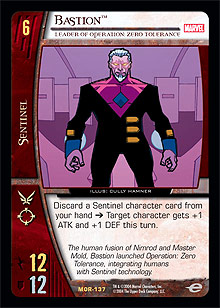
Before all is said and done, some card or combination of cards is going to come off the bench with a killer jump shot. All of these decks have a point guard (
Boliver Trask), a shooting guard (
Sentinel Mark V), a small forward (
Nimrod), a power forward (
Bastion), and a center (Magneto). It's a dead heat in that regard. The real question is, when crunch time calls, what deckbuilding element is going to check into the game and make a big play?
Madden's decision to use
Total Anarchy? The two copies of
Have a Blast! in the deck of Alvaro Jiran? Girijalra's quad Dodges and
Finishing Move? And what about Anthony Cheng's decision to ignore the hype and just play what may be the strongest version, straight out of Detroit?
No need to venture a guess when one day will answer our questions one way or the other. See you tomorrow!